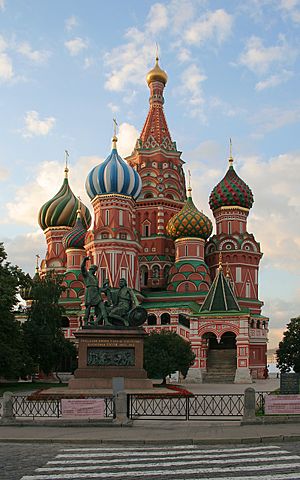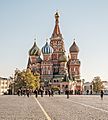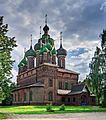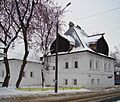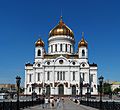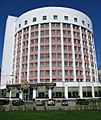Russian architecture facts for kids
Russian architecture is the unique way buildings have been designed and built in Russia for many centuries. It started with simple wooden structures and grew into grand stone cathedrals and palaces. This style shows Russia's rich history, its strong faith, and its connection to different cultures. From ancient times to modern days, Russian buildings tell a story of change and beauty.
Contents
Early Russian Architecture: From Wood to Stone
For a long time, most buildings in Russia were made of wood. Wood was easy to find and work with. People built houses, churches, and even strong forts from logs. These wooden buildings were often very beautiful, with detailed carvings.
The Rise of Stone Buildings
Around the 10th century, Russia started to use more stone for important buildings. This happened after the country adopted Christianity. Stone buildings were stronger and lasted longer. They also allowed for more complex designs, like the grand churches seen in cities today.
Byzantine Influence
Early stone churches in Russia were often inspired by the Byzantine Empire. This was a powerful empire that had a big influence on Russia's culture and religion. Byzantine churches often had domes and detailed decorations. Russian builders learned these techniques and made them their own.
Kievan Rus' Period (10th-13th Centuries)
During the time of Kievan Rus', many impressive stone cathedrals were built. These churches were usually tall and had several domes. They were often decorated with frescoes (wall paintings) and mosaics.
- Saint Sophia Cathedral in Veliky Novgorod (1045–1050) is a great example. It shows the strong, simple style of this early period.
- Another important building is the Transfiguration monastery in Murom (1096). These early stone buildings were often built inside fortified areas called kremlins.
Medieval Russian Architecture: Unique Styles Emerge
After the Kievan Rus' period, different regions of Russia developed their own building styles. These styles often mixed local traditions with older Byzantine ideas.
Vladimir-Suzdal Architecture (12th-13th Centuries)
This style is known for its white stone buildings with beautiful carvings. The carvings often showed animals, plants, and even people. These buildings look very grand and elegant.
- The Golden Gate in Vladimir (1158–1164) was a strong entrance to the city.
- The Church of the Intercession on the Nerl (1165) is famous for its perfect beauty and peaceful setting by a river.
- The Dormition Cathedral in Vladimir (1186–1189) is another stunning example. It has tall, graceful arches and many domes.
Novgorod and Pskov Styles (12th-15th Centuries)
In the northern cities of Veliky Novgorod and Pskov, churches were often simpler and more practical. They were built with rough stone and brick. These churches had a strong, sturdy look, often with one or a few domes.
- The Church of the Transfiguration on Ilyina Street in Veliky Novgorod (1374) is a good example of this style.
Muscovite Architecture: Grandeur and Color
As Moscow grew stronger, its architecture became more important. This period saw the creation of some of Russia's most famous buildings.
The Moscow Kremlin (15th-16th Centuries)
The Moscow Kremlin became the center of Russian power. Many important buildings were constructed inside its walls.
- The Cathedral of the Dormition (1475–1479) was where Russian tsars were crowned. It has a grand, golden-domed look.
- The Palace of Facets (1487–1492) is known for its unique stone facade that looks like cut diamonds.
- The Spasskaya Tower (1491) is one of the most famous towers of the Kremlin, with its iconic clock.
St. Basil's Cathedral (16th Century)
Saint Basil's Cathedral (1482–95) is perhaps the most famous Russian building. It stands in Moscow's Red Square. It is known for its bright, onion-shaped domes and colorful patterns. It looks like a collection of different churches joined together. This style is often called "tent-roof" architecture because of its pointed roofs.
Baroque and Neoclassical Styles (17th-19th Centuries)
Later, Russian architecture was influenced by European styles like Baroque and Neoclassicism. These styles brought more fancy decorations and grand, balanced designs.
- The Winter Palace in Saint Petersburg (1762–1796) is a huge, luxurious palace built in the Baroque style. It was the main home of the Russian emperors.
- The Kazan Cathedral (1801–1811) and Saint Isaac's Cathedral (1819–1858) in Saint Petersburg are grand examples of Neoclassical architecture. They look like ancient Roman temples.
Modern Russian Architecture: New Ideas and Big Projects
In the 20th century, Russian architecture saw many changes. New ideas and building methods led to very different styles.
Constructivism (Early 20th Century)
After the Russian Revolution, a style called Constructivism became popular. It focused on simple, geometric shapes and practical designs. Buildings were meant to be useful and show the new ideas of the time.
- The Shukhov Tower in Moscow is a famous example, looking like a giant metal lattice.
Stalinist Architecture (Mid-20th Century)
This style is also known as "Stalinist Empire style." It was very grand and impressive, often with tall towers and many decorations. These buildings were meant to show the power of the state.
- The main building of Moscow State University is a huge, famous example of this style. It is one of the "Seven Sisters" skyscrapers in Moscow.
Post-Soviet Architecture (Late 20th Century - Present)
After the fall of the Soviet Union, Russian architecture became more diverse. Modern skyscrapers and unique designs began to appear.
- The Lakhta Center in Saint Petersburg is a very tall, modern skyscraper.
- The Moscow International Business Center has many modern towers, showing Russia's growth in the 21st century.
Russian architecture is a fascinating journey through history, showing how different ideas and cultures have shaped the country's buildings. From ancient wooden churches to modern skyscrapers, each building tells a part of Russia's story.
Images for kids
-
Saint Basil's Cathedral (1482–95) is a showcase of Muscovite Russian architecture.
-
Saint Sophia Cathedral in Veliky Novgorod (1045–1050)
-
Saint Nicholas Cathedral in Veliky Novgorod (1113–1136)
-
St. George's Cathedral of Yuriev Monastery near Veliky Novgorod (1119)
-
St. Peter and St. Paul's Church in Smolensk (1146)
-
Golden Gate in Vladimir (1158–1164)
-
St. Michael the Archangel Church in Smolensk (1180–1197)
-
Dormition Cathedral in Vladimir (1186–1189)
-
Cathedral of Saint Demetrius in Vladimir (1194–1197)
-
Church of the Transfiguration on Ilyina Street in Veliky Novgorod (1374)
-
Palace of Facets in Moscow Kremlin (1487–1492)
-
Old English Court - headquarters of English Muscovy Company (1490–1510)
-
Spasskaya Tower in Moscow Kremlin (1491)
-
Palace of Alexis I in Savvino-Storozhevsky Monastery (1652–1654)
-
St. Nicholas Church in Bersenevka (1657)
-
Palace of the wealthy merchant family Pogankin in Pskov (1671–1679)
-
Metropolitan Palace in Yaroslavl (1680th–1690th)
-
Pushkikov's palace in Nizhny Novgorod (1698)
-
Peterhof Palace (1714–1755)
-
Catherine Palace in Tsarskoye Selo (1752–1757)
-
Winter Palace (1762–1796)
-
Kazan Cathedral (1801–1811)
-
Bolshoi Theatre (1821–1825)
-
Tretyakov gallery (1902–1904)
-
Shukhov Tower in Moscow
-
Central Post Office in Ekaterinburg
-
Maxim Gorky Theatre in Rostov-na-Donu
-
Moscow State University main building
-
Typical Khrushchyovka in Nizhny Novgorod
See also
 In Spanish: Arquitectura de Rusia para niños
In Spanish: Arquitectura de Rusia para niños


